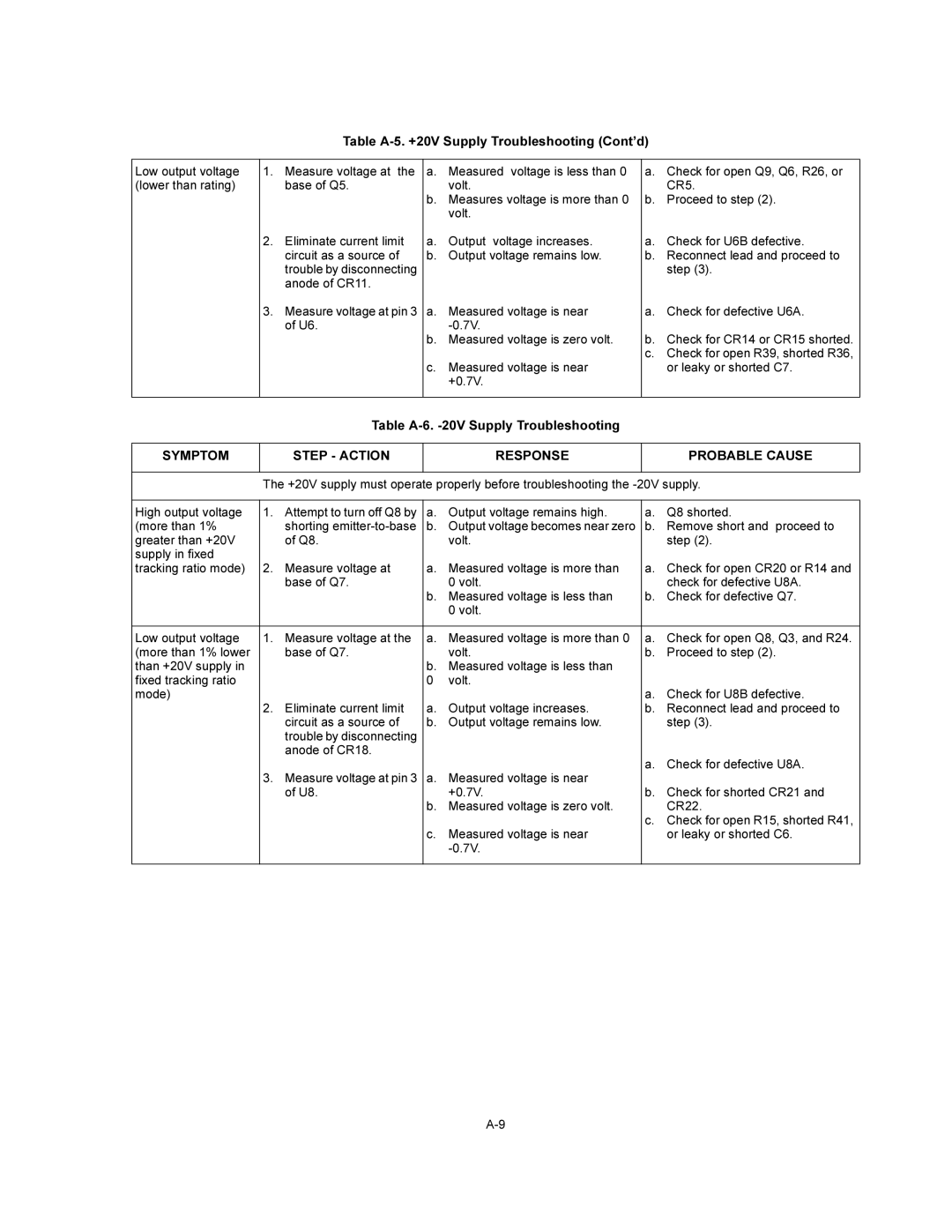Table
Low output voltage | 1. | Measure voltage at the | a. | Measured voltage is less than 0 | a. Check for open Q9, Q6, R26, or | |
(lower than rating) |
| base of Q5. |
| volt. |
| CR5. |
|
|
| b. | Measures voltage is more than 0 | b. | Proceed to step (2). |
|
|
|
| volt. |
|
|
| 2. | Eliminate current limit | a. | Output voltage increases. | a. Check for U6B defective. | |
|
| circuit as a source of | b. | Output voltage remains low. | b. Reconnect lead and proceed to | |
|
| trouble by disconnecting |
|
|
| step (3). |
|
| anode of CR11. |
|
|
|
|
| 3. | Measure voltage at pin 3 | a. | Measured voltage is near | a. | Check for defective U6A. |
|
| of U6. |
|
|
| |
|
|
| b. | Measured voltage is zero volt. | b. Check for CR14 or CR15 shorted. | |
|
|
|
|
| c. Check for open R39, shorted R36, | |
|
|
| c. | Measured voltage is near |
| or leaky or shorted C7. |
|
|
|
| +0.7V. |
|
|
|
|
|
|
|
| |
|
| Table |
|
| ||
|
|
|
|
|
|
|
SYMPTOM |
| STEP - ACTION |
| RESPONSE |
| PROBABLE CAUSE |
|
|
|
| |||
| The +20V supply must operate properly before troubleshooting the | |||||
|
|
|
|
|
|
|
High output voltage | 1. | Attempt to turn off Q8 by | a. | Output voltage remains high. | a. | Q8 shorted. |
(more than 1% |
| shorting | b. | Output voltage becomes near zero | b. | Remove short and proceed to |
greater than +20V |
| of Q8. |
| volt. |
| step (2). |
supply in fixed |
|
|
|
|
|
|
tracking ratio mode) | 2. | Measure voltage at | a. | Measured voltage is more than | a. Check for open CR20 or R14 and | |
|
| base of Q7. |
| 0 volt. |
| check for defective U8A. |
|
|
| b. | Measured voltage is less than | b. | Check for defective Q7. |
|
|
|
| 0 volt. |
|
|
|
|
|
|
|
| |
Low output voltage | 1. | Measure voltage at the | a. | Measured voltage is more than 0 | a. Check for open Q8, Q3, and R24. | |
(more than 1% lower |
| base of Q7. |
| volt. | b. | Proceed to step (2). |
than +20V supply in |
|
| b. | Measured voltage is less than |
|
|
fixed tracking ratio |
|
| 0 | volt. |
|
|
mode) |
|
|
|
| a. Check for U8B defective. | |
| 2. | Eliminate current limit | a. | Output voltage increases. | b. Reconnect lead and proceed to | |
|
| circuit as a source of | b. | Output voltage remains low. |
| step (3). |
|
| trouble by disconnecting |
|
|
|
|
|
| anode of CR18. |
|
|
|
|
|
|
|
|
| a. Check for defective U8A. | |
| 3. | Measure voltage at pin 3 | a. | Measured voltage is near |
|
|
|
| of U8. |
| +0.7V. | b. Check for shorted CR21 and | |
|
|
| b. | Measured voltage is zero volt. |
| CR22. |
|
|
|
|
| c. Check for open R15, shorted R41, | |
|
|
| c. | Measured voltage is near |
| or leaky or shorted C6. |
|
|
|
|
|
| |
|
|
|
|
|
|
|
